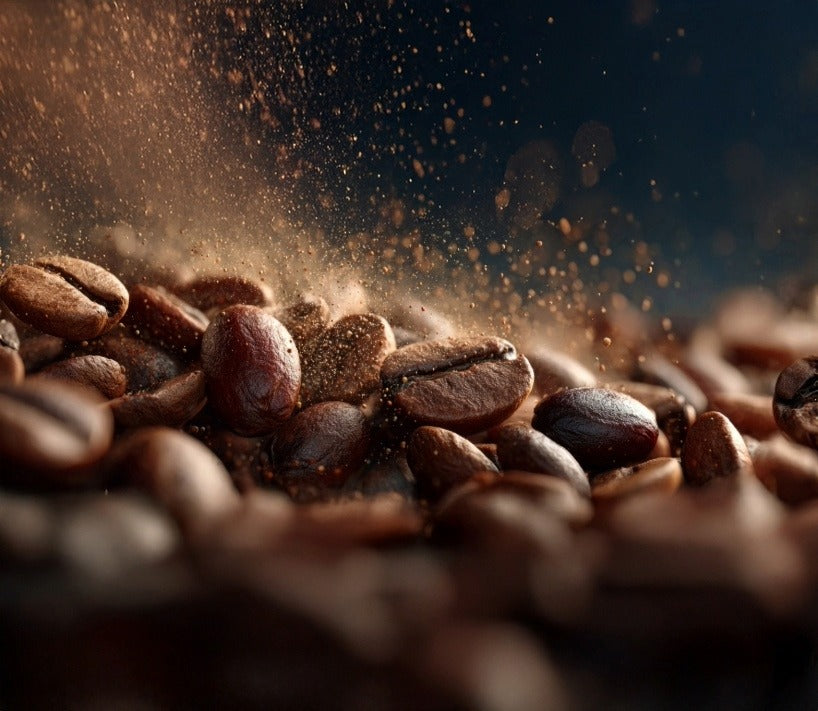Milk Meets Bean: Which Specialty Coffee Origins Shine in Lattes & Cappuccinos?
May 14, 2025 5 min read
Milk Meets Bean: Which Specialty Coffee Origins Shine in Lattes & Cappuccinos (and Why You Still Get the Final Say)
I’ve been there—standing at my kitchen counter, milk pitcher in one hand, bag of best small batch coffee in the other—ready to craft the perfect latte. One silky pour later… and the espresso flavor vanishes faster than my Monday motivation. Was it the milk? The bean? A cosmic prank by the Coffee Gods?
Spoiler alert: some origins really do cozy-up to dairy better than others. But (plot twist) the ultimate flavor referee is always you. Grab a mug and let’s tour the globe to find which specialty coffees strut their stuff in milk drinks—and which might need a little extra coaxing.
1. Why Origin Even Matters in a Milk Drink
Think of espresso as the lead singer and milk as the backup choir. Pick a singer whose voice cuts through, and every cappuccino hits a high note; choose one that whispers, and you’ll wonder why your “flat white” tastes like warm milk with a caffeine cameo. Origin influences three big variables:
-
Body – Heavier-bodied beans (hello, Brazil) stand up to milk. Lighter bodies (many Ethiopians) can fade unless roasted a bit darker.
-
Acidity – Bright, citrusy coffees might taste zingy and refreshing in a cortado—or clash like orange juice after toothpaste.
-
Sweetness & Flavor Notes – Chocolate, nuts, and caramel melt right into dairy; berries and florals can either pop beautifully or play hide-and-seek.
2. The Classic Crowd-Pleasers—Brazil & Colombia
Brazilian lots dish out chocolate, peanut butter, and gentle fruit—flavors that turn lattes into liquid candy bars. Colombian beans layer caramel sweetness and juicy acidity, adding complexity without getting pushy. They’re espresso’s comfort food and a trusty answer to “where can I buy fresh coffee beans near me?”
Try this when you crave: Mochaccino vibes or a cappuccino that tastes like Nutella on toast.
3. Chocolatey Central Americans—Guatemala, Costa Rica, Honduras
Central American coffees bring toffee, cocoa, and stone-fruit. They’re the middle child between Brazil’s nuttiness and Ethiopia’s fruit basket—balanced enough for milk yet exciting in a flat white. Medium roasts from these regions often top “best tasting whole bean coffee” lists for home baristas and rank high among best coffee online guides.
Dial in: 1:2 espresso ratio, 93 °C water, 28–30 s yield. Milk will accentuate sweetness and smooth any lingering citrus.
4. Nutty & Spice Allies—Sumatra & Java
If earthy, spicy notes are your jam (cedar, clove, baking chocolate), Indonesian coffees are your latte’s spirit animal. Their syrupy body muscles through thick dairy and even alternative milks. Darker roasts highlight molasses and brown sugar—perfect when your definition of best craft coffee at home involves a blanket fort and cinnamon-sprinkled foam.
5. Fruit-Forward Adventures—Ethiopia & Kenya
Light-roast Ethiopians scream jasmine, bergamot, and lemon zest—flavors that sometimes clash with milk. Give that same bean a medium roast, though, and suddenly you’ve brewed blueberry muffins slathered in cream. Kenyan coffees add red-currant sparkle that can turn a macchiato into strawberries-and-cream. When you buy specialty coffee online, look for tasting notes that match desserts you already love with dairy.
Pro tip: Oat milk’s cereal sweetness often bridges the gap, making fruity beans more approachable for latte newbies.
6. Wildcards & Rarities—Gesha, Anaerobics, Exotic Hybrids
Need a show-stopping gift for coffee lover friends? Pour a Gesha cappuccino and watch eyes widen. Floral, tea-like origins create peaches-and-cream bliss. Anaerobic fermentations add boozy, jammy flavors that cut through milk like a fruit compote drizzle. They’re not everyday sippers, but they’ll make your home latte art parties legendary.
7. Roast Level & Extraction—The Unsung Heroes
Origin sets the stage, but roast and technique cue the spotlight.
-
Medium to medium-dark roasts caramelize sugars, mellow acidity, and let chocolate/nut notes belt the chorus.
-
Light roasts need precision: slightly lower brew temps (91 °C) and longer pre-infusion coax sweetness before milk joins the party.
-
Your best espresso beans aren’t always labeled “espresso”—plenty of filter roasts from Brazil or Guatemala shine once you adjust grind size and pressure.
8. Dairy vs. Plant Milks—Flavor BFFs or Frenemies?
Whole cow’s milk supplies sweetness plus creamy mouthfeel, but alt milks each bring their own flavor baggage:
-
Oat amplifies brown-sugar and biscuit notes—killer with Colombian or Ethiopian naturals.
-
Almond highlights marzipan vibes that complement chocolatey Guatemalans.
-
Soy stays neutral, letting Sumatra’s spices sing.
9. Altitude, Density, and Why They Matter for Milk
High-altitude beans (think 1,600 m+ Ethiopians or Kenyans) pack denser cell structures. Denser beans need finer grinds and perhaps longer shots to unlock sugars that harmonize with milk. Lower-altitude Brazilians can taste round and nutty with less fuss—great if you’re new to dialing-in espresso at home.
10. The Science of Sweetness—Lactose Meets Sucrose
Milk’s lactose is less sweet than table sugar but fantastic at smoothing edges. Beans roasted just past first crack develop caramel-like sucrose that pairs beautifully with lactose. Voilà: dulce-de-leche-style cappuccinos. If a light-roast Ethiopian still tastes sour, remember: it might need more roast sugar or cooler milk temps—not a break-up.
11. Barista Hacks for Maximum Flavor
-
Bloom first, froth later. Brewing filter coffee for a café au lait? Degas those grounds—goodbye papery flavors.
-
Temperature tango. Milk’s sweet spot is 55–60 °C; hotter and lactose burns, muting bean nuance.
-
Microfoam matters. Tiny bubbles act like flavor taxis, carrying aromatics straight to your nose.
12. When “Best” Is Relative—A Nod to Personal Preference
Maybe you grew up dunking chocolate chip cookies in milk. Guess what? Your brain will likely swoon for Brazilian naturals in a latte because nostalgia says so. Flourish lists of the best specialty coffee online all you want—flavor isn’t math; it’s memories plus chemistry. Some people crave a good coffee to drink black; others want espresso that tastes like strawberry milkshake. That’s why top coffee delivered to your door should always come with room to experiment.
13. Gifting Wisdom—Beans, Milk, and Friendship
Choosing coffee beans as a gift? Pick origins that play nicely with milk unless you know the recipient drinks straight espresso. A medium-roast Guatemalan sits smack-dab in the flavor Venn diagram—safe for both latte lovers and filter purists. Wrap it up, slap a punny note—“Thanks a latte!”—and voilà: the ultimate presents for coffee lovers.
14. Quick Origin-to-Milk Pairing Cheat Sheet
| Origin | Flavor Wins in Milk | Roast Sweet Spot | Milk MVP |
|---|---|---|---|
| Brazil | Chocolate, peanut | Medium-dark | Whole / Oat |
| Colombia | Caramel, red fruit | Medium | Whole / Soy |
| Guatemala | Cocoa, hazelnut | Medium | Whole / Almond |
| Sumatra | Spice, molasses | Dark | Whole / Coconut |
| Ethiopia (natural) | Blueberry muffin | Medium | Oat |
| Kenya (washed) | Strawberry jam | Medium | Oat / Whole |
(Every farm, process, and roast varies—think of this as an espresso compass, not GPS.)
So, do certain origins pair better with milk? Absolutely: Brazil, Colombia, Guatemala, and Sumatra are reliably latte-friendly, while Ethiopia and Kenya can dazzle once dialed in. Still, your palate, brew gear, and milk choice hold the gavel.
Your Action Plan
-
Build a flight. Snag a chocolate-forward Brazil, a caramel-juicy Colombia, and a fruit-bright Ethiopia.
-
Play scientist. Switch roast levels and milk types; note which combinations make you grin.
-
Log the magic. Keep a coffee diary. When that Kenyan flat white tastes like strawberries in cream, circle, star, highlight—then brag to friends.
Whether your beans arrive via the best craft coffee online subscription or a local roaster’s take-home bag, treat these guidelines as your flavor compass. Let curiosity steer, and remember: today’s perfect cappuccino might be tomorrow’s distant memory, replaced by a Kenyan natural that tastes like ice-cream sundae.
Got a mind-blowing milk-bean combo? Drop me a line—I’ll happily geek out over latte art and origin notes. Until then, steam boldly, sip joyfully, and may every cappuccino sing in perfect harmony.
Also in Best Coffee To Buy Online Education

Best Fresh Roasted Coffee Delivery Online
November 28, 2025 4 min read
I roast the best tasting coffee at home for you! I use 100% electric equipment, so no hydrocarbons here. Best fresh roasted coffee delivery starts with high-scoring specialty coffee online.

Which Roaster Makes Better Coffee: Gas or Electric?
November 27, 2025 4 min read
Why electric drum roasters produce cleaner, sweeter, more consistent coffee—especially the kind you want when buying fresh roasted coffee beans online or trying to make the best tasting craft coffee at home.

Biggest Coffee Buying Mistake at Home
November 26, 2025 4 min read
Learn why the roast date matters and how to buy fresh, high-quality specialty coffee online. No guesswork when you order coffee online with me. I only stock, roast, and process the best tasting craft coffee at home. I am YOUR personal roaster.
